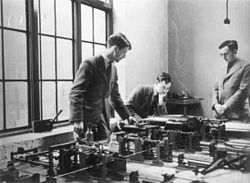മൗറീസ് വിൽക്ക്സ്
സർ മൗറീസ് വിൽക്സ് | |
|---|---|
 1980 ൽ മൗറീസ് വിൽക്സ് | |
| ജനനം | John Maurice Vincent Wilkes 26 ജൂൺ 1913 Dudley, Worcestershire, England |
| മരണം | 29 നവംബർ 2010 (പ്രായം 97) Cambridge, Cambridgeshire, England |
| ദേശീയത | British |
| വിദ്യാഭ്യാസം | King Edward VI College, Stourbridge |
| കലാലയം | University of Cambridge (MA, PhD) |
| അറിയപ്പെടുന്നത് | Cache memory |
| ജീവിതപങ്കാളി(കൾ) | Nina Twyman
(m. 1947; |
| കുട്ടികൾ | one son, two daughters |
| പുരസ്കാരങ്ങൾ |
|
| ശാസ്ത്രീയ ജീവിതം | |
| പ്രവർത്തനതലം | Computer Science |
| സ്ഥാപനങ്ങൾ |
|
| പ്രബന്ധം | The reflexion of very long wireless waves from the ionosphere (1939) |
| ഡോക്ടർ ബിരുദ ഉപദേശകൻ | John Ashworth Ratcliffe[6] |
| ഡോക്ടറൽ വിദ്യാർത്ഥികൾ | |
| വെബ്സൈറ്റ് | www |
സർ മൗറീസ് വിൻസന്റ് വിൽക്സ് [10](ജനനം:26 ജൂൺ 1913 - 29 നവംബർ 2010)[11] കമ്പ്യൂട്ടർ ലോകത്തിന് ശ്രദ്ധേയമായ സംഭാവനകൾ നൽകിയ ഒരു ശാസ്ത്രജ്ഞനാണ് മൗറീസ് വിൻസൻറ് വിൽക്ക്സ്. മൈക്രൊ പ്രോഗ്രാമിംഗ്, പ്രോഗ്രാമിംഗിൽ പ്രധാന്യമർഹിക്കുന്ന മാക്രോകൾ, സബ്റൂട്ടിൻ ലൈബ്രറികൾ എന്നീ തത്ത്വങ്ങൾ അവതരിപ്പിച്ച ശാസ്ത്രജ്ഞനാണ് ഇദ്ദേഹം. ഇലക്ട്രോണിക് ഡിലേ സ്റ്റോറേജ് ഓട്ടോമാറ്റിക് കാൽക്കുലേറ്റർ(EDSAC)എന്ന പ്രോഗ്രാം സ്വന്തമായി സൃഷ്ടിച്ച ആദ്യ കമ്പ്യൂട്ടറിന്റെ സ്രഷ്ടാവെന്ന നിലയ്ക്കാണ് വിൽക്ക്സ് പ്രധാനമായും അറിയപ്പെടുന്നത്. മരിക്കുമ്പോൾ, വിൽക്സ് കേംബ്രിഡ്ജ് സർവകലാശാലയിലെ എമിരിറ്റസ് പ്രൊഫസറായിരുന്നു.
ആദ്യകാല ജീവിതം, വിദ്യാഭ്യാസം, സൈനിക സേവനം
ഇംഗ്ലണ്ടിലെ വോർസെസ്റ്റർഷയറിലെ ഡഡ്ലിയിലാണ് വിൽക്സ് ജനിച്ചത് [12] എലൻ (ഹെലൻ), നീ മലോൺ (1885-1968), വിൻസെന്റ് ജോസഫ് വിൽക്സ് (1887-1971) എന്നിവരുടെ ഏകമകൻ, ഡഡ്ലിയിലെ ഏളിന്റെ എസ്റ്റേറ്റിലെ അക്കൗണ്ട് ക്ലാർക്കായിരുന്നു. [13]പടിഞ്ഞാറൻ മിഡ്ലാൻഡിലെ സ്റ്റോർബ്രിഡ്ജിൽ വളർന്ന അദ്ദേഹം സ്റ്റൂർബ്രിഡ്ജിലെ കിംഗ് എഡ്വേർഡ് ആറാമൻ കോളേജിൽ വിദ്യാഭ്യാസം നേടി. സ്കൂൾ കാലഘട്ടത്തിൽ, രസതന്ത്ര അദ്ധ്യാപകൻ അദ്ദേഹത്തെ അമേച്വർ റേഡിയോയിലേക്ക് പരിചയപ്പെടുത്തി.[14]

1931-34 വരെ കേംബ്രിഡ്ജിലെ സെന്റ് ജോൺസ് കോളേജിൽ ഗണിതശാസ്ത്ര ട്രിപ്പോസ് പഠിക്കുകയും 1936 ൽ അയണോസ്ഫിയറിലെ റേഡിയോ തരംഗങ്ങളുടെ റേഡിയോ പ്രോപോഗേഷൻ എന്ന വിഷയത്തിൽ ഭൗതികശാസ്ത്രത്തിൽ പിഎച്ച്ഡി പൂർത്തിയാക്കുകയും ചെയ്തു.[15]കേംബ്രിഡ്ജ് സർവകലാശാലയുടെ ജൂനിയർ ഫാക്കൽറ്റി സ്ഥാനത്തേക്ക് അദ്ദേഹത്തെ നിയമിച്ചു, അതിലൂടെ ഒരു കമ്പ്യൂട്ടിംഗ് ലബോറട്ടറി സ്ഥാപിക്കുന്നതിൽ അദ്ദേഹം പങ്കാളിയായിരുന്നു. രണ്ടാം ലോകമഹായുദ്ധസമയത്ത് അദ്ദേഹത്തെ സൈനിക സേവനത്തിനായി വിളിക്കുകയും ടെലികമ്മ്യൂണിക്കേഷൻസ് റിസർച്ച് എസ്റ്റാബ്ലിഷ്മെന്റിലും (ടിആർഇ) റഡാറിലും ഓപ്പറേഷണൽ റിസേർച്ചിൽ പ്രവർത്തിക്കുകയും ചെയ്തു.[16]
ഗവേഷണവും കരിയറും
1945 -ൽ, കേംബ്രിഡ്ജ് യൂണിവേഴ്സിറ്റി മാത്തമാറ്റിക്കൽ ലബോറട്ടറിയുടെ (പിന്നീട് കമ്പ്യൂട്ടർ ലബോറട്ടറി എന്നറിയപ്പെട്ടു) രണ്ടാമത്തെ ഡയറക്ടറായി വിൽക്സ് നിയമിതനായി.
കേംബ്രിഡ്ജ് ലബോറട്ടറിയിൽ തുടക്കത്തിൽ ഡിഫറൻഷ്യൽ അനലൈസർ ഉൾപ്പെടെ നിരവധി കമ്പ്യൂട്ടർ ഉപകരണങ്ങൾ ഉണ്ടായിരുന്നു. ഒരു ദിവസം ലെസ്ലി കോമ്രി വിൽക്സ് സന്ദർശിക്കുകയും ജോൺ വോൺ ന്യൂമാന്റെ മൂർ സ്കൂൾ ഓഫ് ഇലക്ട്രിക്കൽ എഞ്ചിനീയറിംഗിൽ പ്രെസ്പെർ എക്കർട്ട്, ജോൺ മോഷ്ലി എന്നിവർ ചേർന്ന് നിർമ്മിക്കുന്ന എനിയാക്കി(ENIAC)ന്റെ[17][18] പിൻഗാമിയായ എഡ്വാക്ക്(EDVAC)ന്റെ പ്രിപ്രസ് ഡിസ്ക്രിപ്ക്ഷന്റെ ഒരു പകർപ്പ് നൽകുകയും ചെയ്തു.
ഇവയും കാണുക
അവലംബം
അവലംബങ്ങൾ എങ്ങനെയുണ്ടെന്ന് കാണുക
- ↑ Wilkes, M. V. (1975). "Early computer developments at Cambridge: The EDSAC". Radio and Electronic Engineer. 45 (7): 332. doi:10.1049/ree.1975.0063.
- ↑ Wilkes, Maurice (1951). "The EDSAC Computer". Proceedings of the Review of Electronic Digital Computers: 79. doi:10.1109/AFIPS.1951.13.
- ↑ Wilkes, M. V. (1969). "The Growth of Interest in Microprogramming: A Literature Survey". ACM Computing Surveys. 1 (3): 139–145. doi:10.1145/356551.356553. S2CID 10673679.
- ↑ Wilkes, M. V. (1996). "Computers then and now---part 2". Proceedings of the 1996 ACM 24th annual conference on Computer science – CSC '96. pp. 115–119. doi:10.1145/228329.228342. ISBN 978-0897918282. S2CID 5235054.
- ↑ മൗറീസ് വിൽക്ക്സ് author profile page at the ACM Digital Library
- ↑ മൗറീസ് വിൽക്ക്സ് at the Mathematics Genealogy Project.
- ↑ Kay, Michael Howard (1976). Data independence in database management systems (PhD thesis). University of Cambridge. EThOS uk.bl.ethos.461558. Archived from the original on 2021-10-07. Retrieved 2021-10-06.
- ↑ Wegner, Peter (1968). Programming Languages, Information Structures, and Machine Organization (PhD thesis). University College London.
- ↑ Wheeler, David John (1951). Automatic Computing With EDSAC. cam.ac.uk (PhD thesis). University of Cambridge.
- ↑ Campbell-Kelly, Martin (2014). "Sir Maurice Vincent Wilkes 26 June 1913 -- 29 November 2010". Biographical Memoirs of Fellows of the Royal Society. 60: 433–454. doi:10.1098/rsbm.2013.0020.
- ↑ "Father of British computing Sir Maurice Wilkes dies". BBC News. 30 November 2010. Retrieved 18 January 2011.
- ↑ "CV for Maurice V. Wilkes" (PDF). University of Cambridge. Retrieved 18 January 2011.
- ↑ Matthew, H. C. G.; Harrison, B.; Goldman, L.; Cannadine, D., eds. (2004-09-23). "The Oxford Dictionary of National Biography". Oxford Dictionary of National Biography (online ed.). Oxford University Press. pp. ref:odnb/103346. doi:10.1093/ref:odnb/103346. ISBN 978-0-19-861411-1. Retrieved 2019-12-07. (Subscription or UK public library membership required.)
- ↑ "Obituaries – Professor Sir Maurice Wilkes". The Daily Telegraph. 30 November 2010. Retrieved 18 January 2011.
- ↑ "Maurice V. Wilkes – Short Biography". cl.cam.ac.uk. Retrieved 30 November 2010.
- ↑ Wilkes, M. V. (1985). Memoirs of a computer pioneer. Cambridge, Massachusetts: MIT Press. ISBN 978-0-262-23122-0.
- ↑ Wilkes, M. (2006). "What I Remember of the ENIAC". IEEE Annals of the History of Computing. 28 (2): 30–37. doi:10.1109/MAHC.2006.41. S2CID 36665440.
- ↑ Piech, Chris (2018). "Debugging" (PDF). stanford.edu. Archived from the original (PDF) on 2021-07-29.
As soon as we started programming, we found to our surprise that it wasn't as easy to get programs right as we had thought. We had to discover debugging. I can remember the exact instant when I realized that a large part of my life from then on was going to be spent in finding mistakes in my own programs.